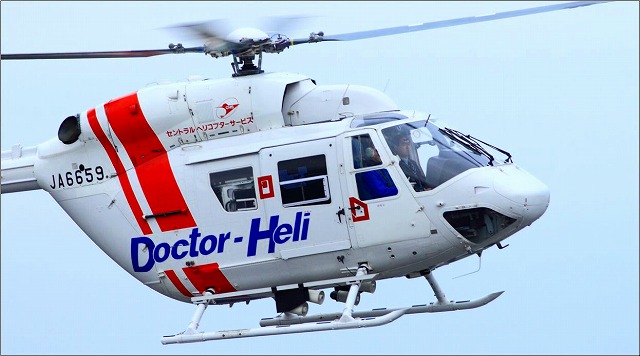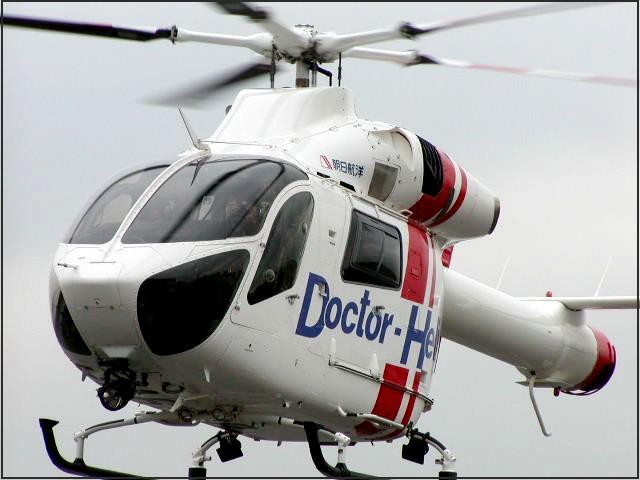<4 RESCUE>
Helicopters
are Kami-sama

本稿は欧州ヘリコプター救急連合会(EHAC)の機関誌 "4 RESCUE" の最近号に掲載されたものである。書いたのは昨年夏。例によって山野豊さんに英訳していただいた。
Trial operation of Japan's Doctor-Helicopter program at two hospitals in 1999. Just a decade has passed since then. Today 18 bases are in service in Japan. We can expect that the program will be expanding in the future.
By the end of this fiscal year (March 31, 2010), we will have several more new programs, and another several are expected during the next fiscal year. It will make a total of nearly 30 programs in the 11th year after the beginning of the Doctor-Heli program. This almost equals the historical fact of German HEMS program that operated 31 bases in the 11th year from its start in 1970. That means Japan's Doctor-Heli is expanding at the almost identical pace as that of the HEMS in Germany. Whatever the progress of our program is, we never forget there was continuous support by Mr. Gerhard Kugler, EHAC Honorary President. His presence for us is like a shadow of a group of the runner promoting Japanese Doctor-Heli program.
Background of Doctor-Heli Expansion In recent years, Japan's medical care system has been in a crisis condition, and has become an object of public concern. These situations were background that the spread of Doctor-Helicopter has been foreseeable. Demand of emergency medical care for aged people has been growing abreast with the rapid aging of population in Japan. Those mothers who bear children at a later age have been increasing and number of abnormal delivery has been increasing consequently. These are common cases worldwide. However, number of difficult cases in properly responding to the demand for emergency medical care has been increasing the shortage of doctors as well as medical facilities.
The social awareness and concern as well as general expectation in for helicopter emergency medical service was growing under the above stated situations. In June 2007, the National Diet legislated a bill to promote the extension of helicopter emergency medical service (HEMS), and in June 2008, a national basic policy that includes a requirement for HEMS system upgrade and expansion was approved in the Cabinet meeting.
In November of the same year, "Diet Member League for Promoting Doctor-Heli" consisting of 20 percent of all the Diet members was founded, further enhancing the program's expansion. In addition, financial support from the central government increased to 75 percent, effective March 2009. Helicopter operation cost was previously covered fully by the public fund. Both local and central governments shared the cost equally. However, medical helicopter cannot be operated easily in a region that is in financial difficulty. The reduction from 50 percent to 25 percent for local governments is made for an increase of fairness in public fund spending. Further reduction is under study. Change of the above financial policy will encourage rapid expansion of the Doctor-Heli program.
10% of Preventable Death How were the results that the well-developed Doctor-Helicopter program carried out? Attached chart indicates the transition of each number of programs established in the past 10 years, the number of missions carried out in each year and the number of patients that received medical care.
An accumulated number of emergency missions performed in the past 10 years totaled about 30,000 times. The number of patients that received medical care would have reached 30,000 in the past 10 years, including an estimated number of patients for the first four years.
How many patients would have died if Doctor-Helicopter was not available? 542 patients out of 2,789 patients that were treated by doctor dispatched by a Doctor-Helicopter died, according to the results of the scientific empirical study that the Ministry of Health conducted in collaboration with many medical specialists in 2003. And the study indicates that 821 patients would have been died if a Doctor-Helicopter was not available. This means 279 patients, difference between 821 and 542, were saved thanks to the Doctor-Helicopter.
Surprisingly, Doctor-Helicopter saved exactly lives of 10 percent of the patients. Some may consider the figure is logically right or some may consider it is by chance. Estimation depends on individual opinion. At any rate, we can estimate that life-or-death of 10 percent of patients depend on availability of Doctor-Helicopter.
Assuming that the abovementioned estimate is correct, we can say the Doctor-Helicopter program saved the lives of 3,000 patients in the past 10 years. All of those patients thank saying "Helicopters are Kami-sama (God)."
The ancient Japanese Shinto religion, unlike Christianity and Islam, says that multitudinous gods exist in the universe. This means that the gods are omnipresent, and we dare say finally the Doctor-Helicopters possess the status as Kami-sama.These flying spirits will continue to save lives across Japan.
W. Nishikawa, director, HEM-Net
English Translation by Y. Yamano, director, HEM-Net
( EHAC "4Rescues" magazine, 4/2009)Results Achieved by Doctor-Helicopters in 10 Years
Note 1: Japanese fiscal year starts on April 1 and end March 31 next year.
Fiscal Year
Stations
Missions
Patients
1999
3
302
N/A
2000
3
827
N/A
2001
6
874
N/A
2002
7
2,262
N/A
2003
7
2,888
2,789
2004
8
3,367
3,266
2005
10
4,098
3,904
2006
11
4,444
4,197
2007
14
5,263
4,901
2008
18
5,635
5,182
Total
---
29,960
---
Note 2: Number of stations became 20 in November 2009, and will be 23 until spring of this year.

